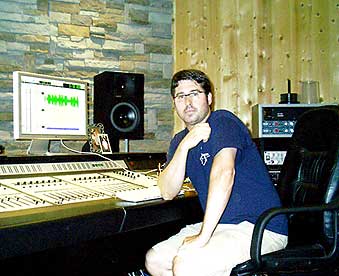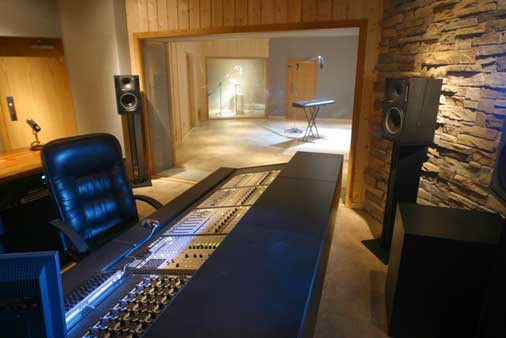|
Some Common Misconceptions
Over the years, I’ve heard people tell me a lot of things that they believe to be true, but aren’t. They hear it from other musicians and pass it on and pretty soon, people start accepting it as absolute fact. The actual truth gets buried in history, and that’s the way myths are born. They’re charming, but inaccurate. Let’s examine some of these myths.
Bass Drum Ports:
There are a lot of drummers that cut a small hole (usually around 4 to 6 inches in diameter) in their front head to “port” their drum. Somebody may have told them that this tunes the drum (like a bass reflex speaker) to improve the bottom end. Is it true? Yes, and no. Cutting a hole will provide a vent which can be tuned to resonate the air inside the drum, but that’s what the second head does anyway - it’s like a passive radiator, driven from the pedal head. Putting a hole in the front head is kinda like putting a hole in your speaker to port your hi-fi system system.
So, why do drummers put that hole in their drums? Primarily to use as an opening for a kick drum mic, without removing the head entirely. A lot of drummers still print the band’s name on their drum head and that’s important to them. That hole is important when you walk into a studio to record. Live drummers saw their studio conterparts using the hole and thought it looked cool, and adopted it.
Where the hole is located is very important, but not for any reason you’d normally think about. It should be above the center line of the drum, so that a short mic stand will work, and the mic stand boom arm angle will let the engineer position the mic to point directly at the spot where the beater hits the head. The hole diameter should be around 6” to allow for various size microphones. The center of the hole should be above the center line of the drum, so that the entire opening is in the upper half of the drum. Any 6” opening above the 9:00 to 3:00 line will work.
Guitar Amps and Speakers:
4 ohms, 8 ohms, or 16 ohms; is one impedance better than the others? Impedance is simply the working load the speakers put across the amplifier’s output terminals. Maximum safe power transfer occurs when the amplifier is correctly matched to the speaker load. On stage, multiple speakers will give you more output, compared to a single speaker and provide increased power handling, but that isn’t important in the studio. Many of the big groups use a little 15 watt amp with a single speaker to record.
Speakers can be wired in many different combinations, so that is why many amplifiers have impedance switches on the back of the head. Which impedance is best? Any of them will work fine as long as the head impedance is set correctly - it depends on the speaker configuration you’re using.
Electric Bass; How Low Does It Really Go:
The main output of a bass E string is primarily around 84Hz, not the 42Hz most bass players imagine. The reason is simple; the string length is too short to produce much fundamental. Yes, it produces some 42Hz, but most of the sound is an octave above that. Which brings up the next question; how do you get more bass out of a system. It’s very simple - you need to move more air. Low bass must move more air, so the answer is more power (to make the speakers you have move further), more speakers (so that each speaker doesn’t have to move as much), or a more efficient ported or horn-loaded cabinet (so that the port and/or horn adds more air motion).
Tubes are better than Transistors:
This one’s a little harder to answer. When transistors first appeared, their distortion characteristics were very different than tubes. Once you exceeded their output range, they simply gave up, all at once and distortion went straight up very quickly. A transistor amp which hit 100 watts at .05 distortion might put out 110 watts, but at 35% distortion. A tube amp distorted slower and more gracefully, often generating 2nd and 4th harmonics - which made the sound even better. The newer breed of MOSFET transistors were able to mimic this kind of distortion, and the gap narrowed. With the new breed of computer modeling amps, and some of the new DSP chips, the gap between tubes and transistors is getting even narrower.
Tubes are noisier than Transistors:
Nope, it depends on the circuit. You can build ultra-low noise tube circuits if you’re willing to take the time to do it right. And let’s get rid of the tubes won’t reproduce high frequencies myth too. For many years, tubes ruled the high frequency roost in the megaHertz range. The main advantage to transistors over tubes is less heat, less susceptible to shock and vibration, and now, lower cost.
There’s no difference in cables and cords: Somewhat true for speaker cables, once you get past the teeny size wires. Not as true for guitar and audio cables. Bad shielding, high capacitance, and poor construction can seriously degrade your sound in any cable carrying low level signals. There are now even some wire companies selling “directional cable,” which is pure bull. All just hype.
Different batteries sound different:
Some people swear they can hear a difference in batteries. I remain sceptical of their claim. Some batteries DO put out more current then other batteries and that MIGHT change the sound but I think different batteries of the same actual voltage and peak current output should sound the same. The jury is still unconvinced on this one.
A condenser mic is the best kind of mic:
Best for what? If that was really true, they would use nothing but condenser mics in major studios. They don’t. EVERY studio has dynamic mics, like the Shure SM 57, the AKG D112, the Sennheiser 421, and usually several ribbon mics and a wide assortment of general purpose mics. Why? Because there is no such thing as the ONE perfect mic for everything. For big ballads, it’s hard to beat the sound of a great big diaphragm condenser mic like the old Neumann U47, which now sells for around $10,000 in primo shape. But even that mic occasionally gets beat out by a Shure SM7 or an old ribbon mic for some voices or some songs. A good engineer doesn’t go by price - he/she will pick whatever works best for that particular sound.
PA amplifier wattage should match PA speaker wattage:
Usually you can double the wattage of the power amplifier to prevent clipping. But if you’re going to be playing loud, invest in a good stereo compressor to go across the output of the mixer to prevent huge spikes from blowing the speakers. Any questions?
(Harvey Gerst), ITR Studios, http://ITRstudio. com
|
 Bart Rose
Bart Rose
|
The facilities at Bart Rose’s Fort Worth Sound may be new, but Rose himself is no stranger to the business. He has spent the last 20 years producing bands and honing his skills as a recording engineer.
“It all started when I was practicing guitar, preparing to be a rock star,” Rose remembers. “My stepfather was very supportive. He would challenge me to bets on whether I could learn to play a particular song or guitar solo. When I was 19, we had a bet on whether I could learn to play Eddie Van Halen’s ‘Eruption.’ If I learned it well, [my Christmas present would be a] Carvin Half-Stack amp setup. If I lost,” he says, “I would have to make a naked midnight jog through the neighborhood wearing nothing but cowboy boots.”
Rose stepped up to the challenge and won the bet, but the stakes ironically changed in a way that would also change his life. “At some point before Christmas,” Rose notes, “my dad asked what I thought about receiving a drum machine and four-track cassette recorder instead. I thought that would be a great way to start recording my own stuff, so I agreed. I started recording my own songs, got four of them featured on Q102’s Texas Tapes, and it all went crazy from there. I was bitten by the recording bug.”
Rose spent several years under the name First Street Audio, where he recorded and produced many of Fort Worth/Arlington’s best-known bands. On January 1, 2008, he moved to his new, high-tech facility on Main Street in Fort Worth and changed the name to Fort Worth Sound. Rose and his assistant, Michael Garcia, spent the first week wiring things up and familiarizing themselves with the rooms. By the second week of January, Noah and Lester from Pillar were in studio, producing One Minute Halo’s first full-length record.
 It has been a steady stream of business since then — from noteworthy clients, at that. “Most recently, we hosted The Toadies for their new record, No Deliverance,” he reveals. “Michael and I assisted, while David Castell (Burden Brothers, Blue October) produced. Other past and present clients include Buddy Miles, Valeyra, Little Green Men, Travail. No Scope, Determination, and the list goes on...”
It has been a steady stream of business since then — from noteworthy clients, at that. “Most recently, we hosted The Toadies for their new record, No Deliverance,” he reveals. “Michael and I assisted, while David Castell (Burden Brothers, Blue October) produced. Other past and present clients include Buddy Miles, Valeyra, Little Green Men, Travail. No Scope, Determination, and the list goes on...”
Rose’s impressive ear for intonation and balance is one reason for Fort Worth Sound’s growth. Another is the great rooms and first-rate equipment they offer. The main weapon is a Pro Tools HD3 rig on a Mac G5. The mixing console is a Digidesign ProControl with 24 faders.
“The Pro Control is an amazing console as it allows you to get your hands off the computer mouse more and turn real knobs and move real faders like an analog console,” Rose explains. “The difference is, with a control surface like ProControl, everything is automatable and recallable. This type of mixing saves hours of time if a mix ever needs to be recalled and changed for any reason.”
The studio also offers both tube and solid state outboard mic preamps by Avalon, Universal Audio, Great River, Vintech, Trident and more; compressors and EQ by Manley, Empirical Labs and Waves; plus over 50 microphones, from tube to ribbon to standard dynamic mics by makers like Neumann, Royer, AKG, Sennheiser, Audix and others. “To put it short,” says Rose, “we have a mic for every job.”
For booking and contact information, as well as a complete equipment and client list, visit fortworthsound.com or myspace.com/ fortworthsound.
|


 It has been a steady stream of business since then — from noteworthy clients, at that. “Most recently, we hosted The Toadies for their new record, No Deliverance,” he reveals. “Michael and I assisted, while David Castell (Burden Brothers, Blue October) produced. Other past and present clients include Buddy Miles, Valeyra, Little Green Men, Travail. No Scope, Determination, and the list goes on...”
It has been a steady stream of business since then — from noteworthy clients, at that. “Most recently, we hosted The Toadies for their new record, No Deliverance,” he reveals. “Michael and I assisted, while David Castell (Burden Brothers, Blue October) produced. Other past and present clients include Buddy Miles, Valeyra, Little Green Men, Travail. No Scope, Determination, and the list goes on...”